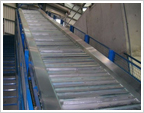A conveyer
system is a conventional piece of mechanical handling equipment that moves
materials from one place to another. Conveyors are mainly used for the
transportation of heavy or bulky materials. Conveyer systems enable quick and
efficient transportation for a wide variety of materials which have made them
very popular in material handling and packaging industries. Conveyer rollers are the most commonly
used conveyer systems, they can also be called as the backbone of businesses
around the world. They are trustworthy, ductile and extremely practical. Such
conveyers are built to deal with flat bottomed objects like boxes and tote
bins.
There are mainly
three types of conveyer rollers and
they are as follows:
- Belt conveyors
- Gravity roller conveyors
- Live roller conveyors
Belt Conveyors:
The belt
conveyor is usually made up of with two or more pulleys, with a continuous
movement of the belt rotating to move the product. One or both of the pulleys
are powered, moving both the belt and the product on the belt forward. Belt
conveyors can come with flat bed or on rollers. Each serves particular need,
belt conveyors are mostly used to move the products from one level to the next
either up or down. With a lighter product, a limited amount of use of rollers
can also provide you with a quieter system.
Gravity Roller
conveyors:
Gravity roller
conveyors have metal rollers that roll on a fixed shaft as the rollers are
equally spaced to allow free movement. This type of conveyor is slightly
inclined as gravity is used to used to move the object along its length.
Gravity rollers can carry numerous objects placed on the conveyor at one time.
Placing the rollers closer to one another will increase the overall capacity of
the conveyer as well as this provides a smoother rolling package.
Live Roller
Conveyors:
Live roller
conveyors also have metal rollers on which an object can be placed and
transported to the desired location. Unlike gravity rollers, live roller
conveyors use mechanical power or line shaft drive system. The most common
speed of live roller conveyor ranges from 40 to 100 feet per minute. The
industries out there that need to start and stop the conveyor for merging and
sorting out products will employ the live rollers for their work, as live
rollers provide complete control during product transportation.
Thus, conveyor
rollers are the most cost-effective alternative for material handling.

No comments:
Post a Comment